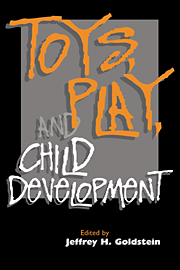Book contents
- Frontmatter
- Contents
- Acknowledgments
- List of contributors
- Introduction
- 1 Imaginative play and adaptive development
- 2 Play, toys, and language
- 3 Educational toys, creative toys
- 4 The war play debate
- 5 War toys and aggressive play scenes
- 6 Sex differences in toy play and use of video games
- 7 Does play prepare the future?
- 8 Play as healing
- References
- Name index
- Subject index
8 - Play as healing
Published online by Cambridge University Press: 07 October 2009
- Frontmatter
- Contents
- Acknowledgments
- List of contributors
- Introduction
- 1 Imaginative play and adaptive development
- 2 Play, toys, and language
- 3 Educational toys, creative toys
- 4 The war play debate
- 5 War toys and aggressive play scenes
- 6 Sex differences in toy play and use of video games
- 7 Does play prepare the future?
- 8 Play as healing
- References
- Name index
- Subject index
Summary
Introduction
Jean Piaget, the psychologist, asked, “Why indeed does the child play at being a shopkeeper, a driver, a doctor?” He believed that a child formed a “vast network of devices which allow the ego to assimilate the whole of reality, i.e., to integrate it in order to relive it, to dominate it or to compensate. Even games with dolls, which might lend themselves to a special interpretation, are much less pre-exercise of the maternal instinct than an infinitely varied symbolic system which provides the child with all the means of assimilation it needs in order to rethink past experiences” (1962).
The children I work with not only relive their past experiences through play but also try to work out current conflicts that relate to themselves or to their caregivers. Just as Piaget observed his own children trying to “liquidate” disagreeable situations by reliving them in their make-believe play, I too believe that play can be healing.
Parents often ask, “What is play therapy?” They want to know how play can lead to growth and how it can help ease the pain their child is experiencing. I think it is important to make a distinction between “just playing” and play therapy. The therapist adopts a particular orientation or strategy that may include a variety of treatment approaches, depending on the nature of the child's disturbance, temperament, and age.
- Type
- Chapter
- Information
- Toys, Play, and Child Development , pp. 147 - 165Publisher: Cambridge University PressPrint publication year: 1994
- 1
- Cited by

